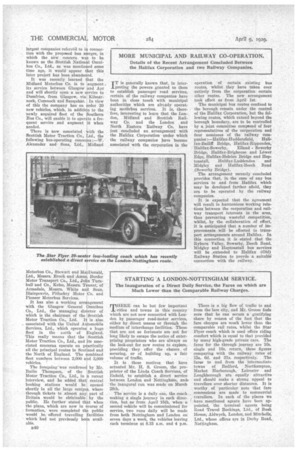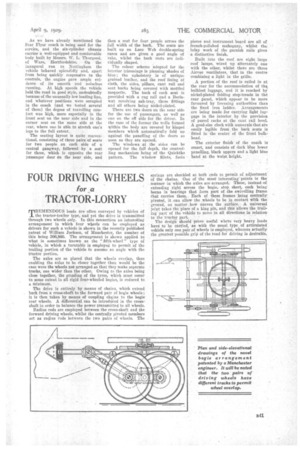STARTING A LONDON-NOTTINGHAM SERVICE.
Page 66

Page 67

If you've noticed an error in this article please click here to report it so we can fix it.
The Inauguration of a Direct Daily Service, the Fares on which are Much Lower than the Comparable Railway Charges.
riviERE can be but few important _L cities and towns in this country which are not now connected with London by passenger road-motor services, either by direct means or through the medium of interchange facilities. Those that are not so fortunate are not for long likely to escape the notice of enterprising proprietors who are always on the look-out for new routes to explore, providing they offer the chance of securing, or of building up, a fair volume of traffic.
It is these motives that have actuated Mr. H. S. Groom, the proprietor of the Linda Coach Services, a Enfield, to establish a direct service between London and Nottingham, andthe inaugural run was made on March 28th.
The service is a daily one, the coach making a single journey in each direction, but as from April 15th, when a second vehicle will be commissioned for service two runs daily will be made from both Nottingham and London on seven days a week, the vehicles leaving each terminus at 8.15 a.m. and 4 p.m.
There is a big flow of traffic to and from the lace city„ and Mr. Groom feels sure that he can secure a gratifying share by reason of the fact that the fare charges are much lower than the comparable rail rates, whilst the Star Elyer coach which is used offers riding comfort which is equal to that provided by many high-grade private cars. The fares for the through journey are 10s. single and 16s. return, these figures comparing with the railway rates of
15s.. 6d. and 31s. respectively. The fares to and from the intermediate towns of Bedford, Northampton, Market Harborough, Leicester and Loug,hborough are equally attractive and should make a strong appeal to travellers over shorter distances. It is worthy of particular note that fare concessions are made to commercial travellers. In each of the places we have mentioned agents have been appointed, the terminal agents being Road Travel Bookings, Ltd., of Bush House, Aldwych, London, and Mitchell% Ltd., whose offices are in Derby Road, Nottingham. As we have already mentioned the Star Flyer coach is being used for the service, and the six-cylinder chassis carries a well-equipped and comfortable body built by Messrs. W. L. Thurgood, of Ware, Hertfordshire. On the inaugural run to Nottingham the vehicle behaved splendidly and, apart from being quickly responsive to the controls, the engine gave ample evidence of its smooth and noiseless running. At high speeds the vehicle held the road in good style, undoubtedly because of the unusually low loading line, and whatever positions were occupied in the coach (and we tested several of them) the degree of travelling comfort was high, more especially in the front seat on the near side and in the corner seat on the same side at the rear, where one is able to stretch one's legs to the full extent.
The seating layout is quite conventional, consisting of three pairs of seats for two people on each side of a central gangway, followed by a seat for three, which is opposite the rear passenger door on the near side, and
then a seat for four people across the full width of the back. The seats are built up on Lace Web double-spring cases and are given a good angle of rake, whilst the back rests are individually shaped.
The colour scheme adopted for the interior trimmings is pleasing shades of blue; the upholstery is of antique grained leather, and the roof lining of cloth, the sides, pillars, cant rail and seat hacks being covered with mottled moquette. The back of each seat is provided with a rug rail and a Bealewat revolving ash-tray, these fittings and all others being nickel-plated. There are two doors on the near side for the use of passengers, as well as one on the off side for the driver. In the case of the former the wells formed Within the hetly are covered by hinged menibers which automatically fold up against the panelling of the doors so soon as they are opened.
The windows at the sides can be opened for the full depth, the .cootrolling mechanism being of the Quicktho pattern. The window fillets, facia. pieces and instrument board are all of french-polished mahogany, whilst the. inlay work of the garnish rails gives a distinctive finish.
Built into the roof are eight large roof lamps, wired up alternately one with the other, whilst there are three Airvac ventilators, that in the centre combining a light in the grille.
A portion of the roof is railed in at the rear for the accommodation of the balkiest luggage, and it is reached by nickel-plated folding step-treads in the rear panel, which appear to be more favoured by licensing authorities than the fixed iron -ladder. Arrangements are being made for carrying light lug-. gage in the interior by the provision of parcel racks at the cant rail level. A good-size clock with numerals that arc easily legible from the back seats is fitted in the centre of the front bulkhead.
The exterior finish of the coach is smart, and consists of dark blue lower panelling, black uppers and a light blue hand at the Waist.height.




















































































































